Korean celebrates 50 years of spectacular growth
04 March, 2019
4 min read
By joining our newsletter, you agree to our Privacy Policy


Korean Air is celebrating its 50th birthday this week with more than 10 billion kilometres on the clock, a fleet that is 21 times bigger than when it was privatized in 1969 and an eye to the future.
In celebrating the birthday in Seoul on March 4, Korean is using the reverse logic to that used by British Airways to arrive at the date of its 100th-anniversary celebrations.
The Koreans are discounting antecedents such as Korean National Airlines, founded in 1946, and the government-owned Korean Air Lines founded in 1962.
Instead, they mark the privatization and takeover by the Hanjin Group on March 1, 1969, as the starting point of the modern airline.
Nonetheless, it has been a half-century of phenomenal growth, as figures released by the airline on Monday illustrated.
Korean launched in 1969 with eight aircraft and now has 166.
Annual passenger numbers have burgeoned from 700,000 to 26. 8 million and the airline estimates it has carried more than 7.14 billion people since its inception as well as 40.54 million tons of cargo.
Back in 1969, Korean operated 49 domestic services a week and six internationally. That has now grown to a weekly tally of 503 domestic flights, 922 international services and 113 freighter flights.
Revenues have increased a whopping 3,154 times and total assets have grown by 4,280 times while employee numbers have jumped from 514 to 20, 654.
Milestones lauded by the airline included services to Russia and China in the 1990s and its role as one of the founding members of SkyTeam in the 2000s.
More recently it played a significant role in the P PyeongChang Winter Olympic and Paralympic Games, started exploring new markets through a joint venture agreement with long-time partner Delta Air Lines and in June, it will host the International Air Transport Association’s annual conference.
It has also launched a “Vision 2013” program aimed at achieving sustainable annual growth of 5.1 percent and increasing its fleet size to 190 aircraft.
Programs include looking at new routes to Europe and Southeast Asia with Delta, boosting profitability in in-flight meals and sales as well as improved governance.
President Walter Cho said the company would strive to improve employees’ happiness, build a constructive rapport with business partners, enhance customer satisfaction, and maximize shareholder value.
"We will do our best to satisfy our customers, raise the happiness of our employees and enhance the value of our shareholders, which will ultimately increase the value of Korean Air,” he said.
However, the airline’s history has not been without its past challenges.
The Aviation Safety Network’s database shows five fatal accidents under the Korean Air Lines banner, including a Boeing 747 that was shot down by Soviet fighters, and five after it changed its name to Korean Air in 1984.
The 1997 crash of Korean Air Flight 801 highlighted a cultural problem with crew resource management after the captain failed to adequately brief and execute a non-precision approach in Guam and the Boeing 747 plowed into a hill. The first officer and flight engineer failed to effectively monitor and cross-check the captain’s approach and there were concerns about fatigue and training.
The crash killed 228 of the 254 people on board and prompted Korean to look at communications in the cockpit and how they were impacted by cultural factors.
The crash of a cargo flight in London two years later prompted further call for changes to be made and the airline launched a $US200m program to improve safety that included turning over much of its pilot training to outsiders.
The airline has not had another fatal accident since the London incident and currently enjoys the maximum safety rating of seven stars with AirlineRatings.
READ our ratings for Korean Air.
Other controversies include the airline’s involvement in Korea’s chaebol system and embezzlement charges leveled against its chairman, Cho Yang-ho.
There was also infamous “nut rage” incident in which the chairman’s daughter, Heather Cho, ordered a plane to return to the gate so that a flight attendant who had served her nuts in a bag rather than on a plate could be removed.
Next Article
2 min read
Qantas triples profit but misses mark

Get the latest news and updates straight to your inbox
No spam, no hassle, no fuss, just airline news direct to you.
By joining our newsletter, you agree to our Privacy Policy
Find us on social media
Comments
No comments yet, be the first to write one.
